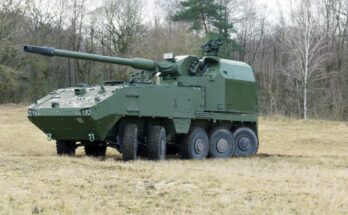by Richard Pettibone, Aerospace & Defense Companies Analyst, Forecast International.
Following a difficult year into the company’s rebranding, Leonardo’s management has launched another industrial plan, dubbed Leonardo 2.0, that aims to achieve double-digit profitability over the next five years, tighten project cost control, and invest some EUR500 million ($624 million) in core technologies. This move follows lackluster results for 2017, which saw sales drop 4 percent – from EUR12.0 billion in 2016 to EUR11.5 billion in 2017. The company reported net income of EUR274 million for the year, compared to EUR507 million for 2016.
“After a challenging 2017 in which we re-set expectations, we intend to deliver an Industrial Plan to return Leonardo to long-term sustainable growth,” said Alessandro Profumo, CEO of Leonardo. “We face attractive market improvement, we are taking actions to leverage off a new commercial strategy, we enjoy a strong backlog, and we know we can invest well for growth in enhancing further core products and technologies. We have taken actions to address short-term issues in our world-class Helicopters business. 2018 is a consolidation year, and we are confident we are laying the seeds for a new phase of sustainable growth with steady improvement in our top line, profitability and cash flow, to create value for of all the stakeholders of the company.”
Under the earlier One Company initiative, Leonardo consolidated its legacy companies of AgustaWestland, Alenia Aermacchi, Selex ES, Oto Melara, and WASS into seven divisions. These divisions now focus on their core markets in the helicopter, aircraft, aerostructures, space, and catchall electronics, defense, and security systems sectors. Previously, the headquarters of Finmeccanica acted as more of a holding company for the aforementioned operating brands. The aim of the One Company initiative is to cut costs by removing duplication in areas such as R&D, and to divest unprofitable activities across the board.
The new Leonardo 2.0 effort plans to double down on this focusing effort and may see the company divest additional operations to tighten its key divisions. In Leonardo’s case, this means concentrating on operations in the aerospace, defense, and security industries. Over the next five years, operations that do not fit into this paradigm will be divested, merged, or closed. This ongoing portfolio trimming should help the firm improve its focus and better deploy limited resources to support continued growth in an increasingly competitive aerospace and defense market.
In addition, the company plans to broaden its international presence to counter anemic sales at home. Over the next few years, Leonardo plans to open 10 international offices around the world in order to be closer to target customers. Growth of international defense budgets is expected to continue and, by gaining proximity to customers, Leonardo is hoping to gain advantage on upcoming procurements. According to reports, these new offices will target some EUR20 billion in new business from 70 contract competitions.
Leading the company’s aerospace operations is Leonardo Helicopters, which stumbled a bit in 2017 due to production issues leading to delivery delays. In addition, there is speculation that the company may close its Yeovil factory in the U.K. Simply put, the facility needs more orders for the products produced there – the AW101 Merlin naval transport and the AW159 Wildcat ASW variant.
In fixed-wing aircraft markets, rationalization is underway. Alenia Aermacchi’s trainers have enjoyed success for many years, but that run is slowing. Leonardo is working on existing orders for Poland and Italy. Deliveries to both customers will wrap up in 2018, so the manufacturer needs additional orders to keep the M-346 line open. One opportunity for the company is the U.S. Air Force’s T-X jet trainer program. After the departure of Raytheon in January 2017 from a joint effort to win the U.S. Air Force’s T-X trainer competition, Leonardo decided to forge ahead alone through its U.S. subsidiary. The bid will be a longshot for the company, as the new Trump administration will expect an “American” company to be awarded the program.
Long-simmering troubles with the Sukhoi Superjet program finally reached a boiling point in late 2016. According to reports, Leonardo has experienced no significant returns on investment on the project. Exacerbating the situation, no doubt, is the political issue of Russia’s aggression in Ukraine. These issues led Leonardo to pull out of the Sukhoi Civil Aircraft Company and the SuperJet International venture.
At the company’s semi-autonomous U.S. subsidiary, Leonardo DRS, the future appears secure after years of speculation that it might be divested. DRS was acquired for $5.2 billion in 2008, shortly before the financial crisis struck. The value of the deal has since plummeted, with DRS’s sales reported at almost $1.8 billion for 2017 in Finmeccanica’s annual report. As a result, DRS underwent significant cost-cutting through both divestitures and layoffs, reducing its employee count from a high of 10,000 to about 5,500 currently. In the long run, management is betting that further globalization of U.S. military goods and services will occur, and that the new leaner DRS will be ready to capture its share of the market.
The actions undertaken so far make it clear that the strategy of Leonardo’s management is on the right path. While there will be some near-term pain financially, the long-term outlook should be stable.
The Defense & Aerospace Companies series focuses on worldwide aerospace and defense prime contractors and subcontractors. Concise reports provide data on individual corporations regarding recent mergers, restructurings, and joint ventures, along with a Strategic Outlook that examines the company’s strengths, weaknesses, and opportunities. Also included in each report are financial and industrial segment data and snapshot coverage of major aerospace and defense programs.
For 50 years, Forecast International intelligence reports have been the aerospace and defense industry standard for accurate research, analysis, and projections. Our experienced analysts compile, evaluate, and present accurate data for decision makers. FI's market research reports offer concise analysis of individual programs and identify market opportunities. Each report includes a program overview, detailed statistics, recent developments and a competitive analysis, culminating in production forecasts spanning 10 or 15 years. Let our market intelligence reports be a key part of reducing uncertainties and mastering your specific market and its growth potential. Find out more at www.forecastinternational.com




